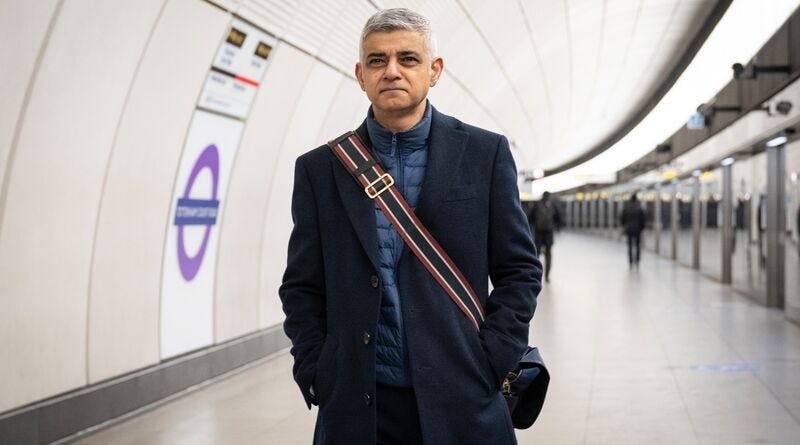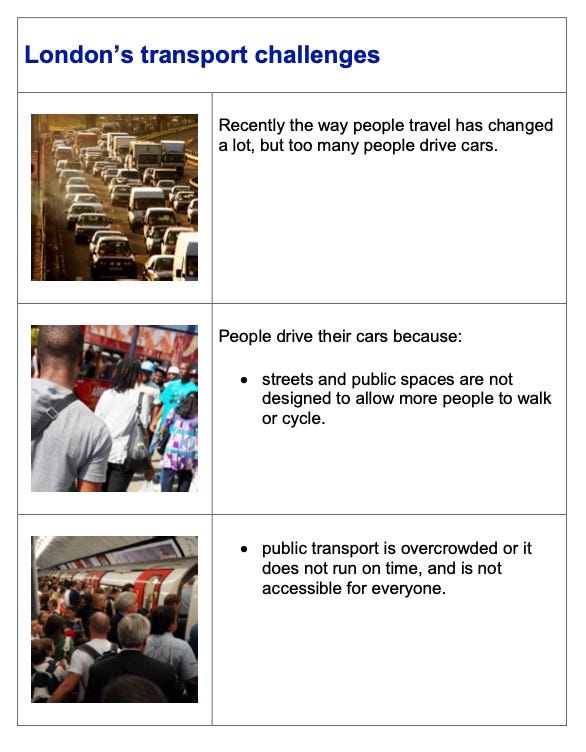How the Mayor sees London in 2041
Mayor Khan's 2018 Strategy outlined how he sees the city's transport working in 2041. And how he intends to make it happen - story 29
This is another of these establishing Posts that requires a freshly brewed mug of coffee. In the early stages of this blog, I am outlining my broad argument across a range of topics.
This is the first of what will be many articles, I suspect, in the Mayor’s Transport Strategy (MTS) which was published in March, 2018.
Transport is arguably the most important part of the Mayor’s responsibility. It affects the city’s quality of life, environment and economy. This chart from the strategy document shows how it relates to other Mayoral strategies such as housing, culture and the environment, making real its influence.
The Mayor has to publish a strategy: it is legally required under the Greater London Authority Act 1999. The Mayor has direct control over Transport for London (TfL), which manages the Underground, buses, trams, cycling infrastructure, and major roads. Over 27 million journeys are made daily on London’s transport network.
Previous Mayors changed London
Mayor Khan’s predecessors left their mark on the city.
Ken Livingstone (2000-2008)
Congestion Charge cut central London traffic by 15% and funded better public transport.
Bus revolution provided Oyster cards, more buses, including the (controversial) bendy ones.
Overground expansion improved suburban connectivity.
Boris Johnson (2008-2016)
Cycle Superhighways and ‘Boris Bikes’ changed London’s transport culture with its dedicated bike lanes and public bike-sharing scheme.
Crossrail (renamed the Elizabeth Line), though completed later, revolutionised east-west travel. Johnson secured funding and supported the development for London’s biggest rail project.
New Routemaster buses were costly but stylish, even iconic.
2018 MTS
There’s a useful website where you can fill your boots with explanations aplenty about the Strategy.
The long version of the MTS is here and runs to 320 pages.
The short ‘easy read’ version is here. No slouch, it covers 49 (much easier to read) pages. I have that printed out, by my side as I write. It looks like this:
There is an important 2022 addendum to the MTS, called MTS Addendum Proposal 24.1. Rolls off the tongue, eh? I’ll return this in a later post.
Mayor Khan’s approach
This is the first big call when thinking about the strategy.
I said earlier how transport affects the city’s quality of life, environment and economy. How you order those three things is at the heart of what to do with transport in London. Mayor Khan adopted the Heathy Streets Approach which makes health and personal experience the priority.
I would start here, were I reading the MTS for the first time.
It has a huge influence on what follows. Cutting to the chase, this meant “helping everyone to use cars less and to walk, cycle and use public transport more.” That becomes Policy 1.
MTS argues
“streets make up 80% of London's public spaces - making them Healthy Streets will improve the quality of life for everyone in London. Public transport is the most efficient way for people to travel distances that are too long to walk or cycle’"
Meanwhile
“London needs 65,000 new homes every year to meet demand, plus around 1.3 million more jobs by 2041. We have an opportunity to reshape London and make sure it grows in a way that improves the quality of life for everyone.”
Type and scale of benefits
There are 26 policy statements in this document as well as 107 proposals. It is dense.
The policy statements are designed to guide the strategic direction and actions aimed at achieving the Mayor's vision for London's transport system. They serve as clear articulations of the Mayor’s intentions and commitments across all transport-related areas.
The proposals serve as the actionable steps and initiatives designed to implement the broader policies and achieve the overarching vision and aims of the strategy. Together they provide the detailed roadmap for how the strategic objectives and policy commitments will be translated into tangible changes on the ground.
The strategy clearly calls out the preferred outcomes, in pages 304-309. Although the design makes reading them harder than it should be, they remain simple and powerful:
London’s streets will be healthy and more Londoners will travel actively
London’s streets will be safe and secure
London’s streets will be used more efficiently and have less traffic on them
London’s streets will be clean and green
The public transport network will meet the needs of a growing London
Public transport will be safe, affordable and accessible to all
Journeys by public transport will be pleasant, fast and reliable
Active, efficient and sustainable travel will be the best option in new homes and job developments
Transport investment will unlock the delivery of new homes and jobs
There are measures and targets attached to all of these statements.

Strategy update
In November 2022, there was a major revision to the strategy.
This is the gloriously titled Addendum to the Mayor’s Transport Strategy (MTS): Proposal 24.1.
The climate emergency was one of the drivers the original 2018 transport strategy. That aimed to make London a greener, healthier and more sustainable city. In the same year, the Mayor also set a goal for London to be net zero by 2050. This was outlined in his London Environment Strategy and 1.5°C Climate Action Plan.
Recognising the urgency of the climate crisis, the Mayor subsequently brought forward the target for London to be net zero to 2030. This updated goal was central to the Element Energy report ‘London Net Zero 2030: An Updated Pathway’ which was published by the GLA in January 2022.
Following this report, the Mayor announced his preferred pathway - the Accelerated Green pathway - to achieving net zero within eight years. This is what the Addendum covers.
Two other things are worth calling out along with this aggressive new target.
There was new modelling that showed to hit the 2030 net zero target, London would need to reduce car traffic by at least 27%.
And secondly, the Mayor working with the boroughs, would address the triple challenges of toxic air pollution, the climate emergency and traffic congestion
through road user charging schemes including by expanding the Ultra Low Emission Zone London-wide.
Reporting progress
The TfL board review the progress made delivering the MTS in a number of ways.
The most important is the annual review. This is the 2023/24 annual review.
Other bodies have also produced their assessment of what, if any, progress has been made. I will go through this in a later post.
I will also look in more detail at some of the dynamics revealed by then TfL research - for example, car ownership and modal share.
My initial thoughts
I have lived in London for 28 years.
During that time I have written, reviewed and contributed to countless similar strategies, but for media. I have also been responsible for delivering some. I find these fascinating.
I believe this strategy is way more right than wrong.
I agree with the approach.
I agree with the outcomes. My case for changing Hammersmith Bridge was anchored on climate, place and health.
I agree with 2041 aims. Later I will focus on just a few of these. I am a blogger, not the Mayor.
Next I want to see how much progress we are making seven years after its launch. What does that say about how we think about the future of Hammersmith Bridge?





